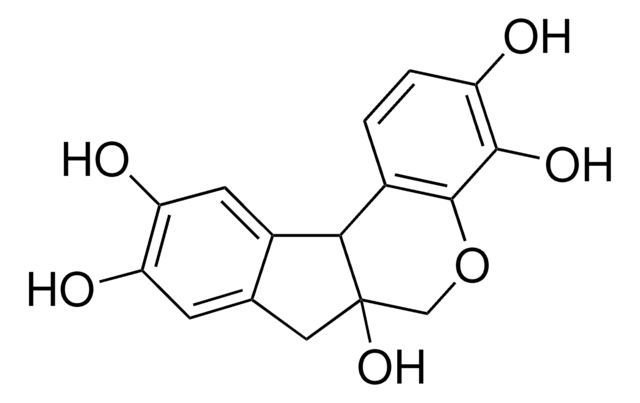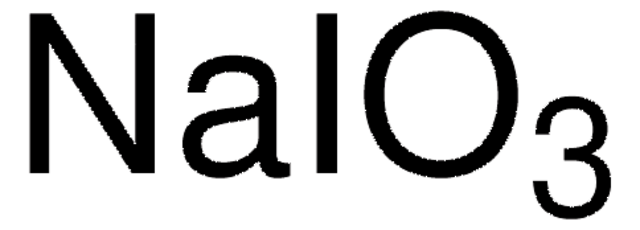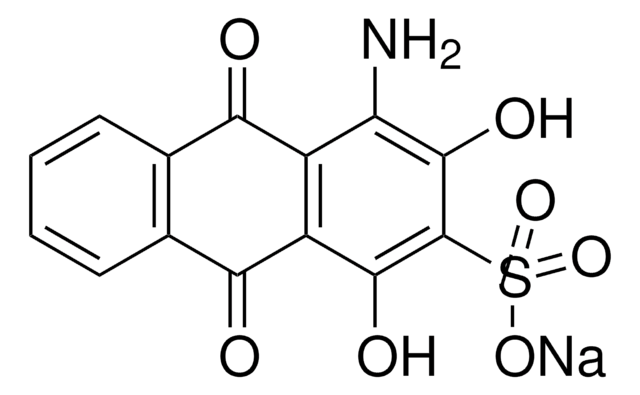All Photos(4)
About This Item
Linear Formula:
NaIO3
CAS Number:
Molecular Weight:
197.89
EC Number:
MDL number:
UNSPSC Code:
12352302
PubChem Substance ID:
NACRES:
NA.22
Recommended Products
Quality Level
Assay
≥99%
density
4.28 g/mL at 25 °C (lit.)
SMILES string
[Na+].[O-]I(=O)=O
InChI
1S/HIO3.Na/c2-1(3)4;/h(H,2,3,4);/q;+1/p-1
InChI key
WTCBONOLBHEDIL-UHFFFAOYSA-M
Looking for similar products? Visit Product Comparison Guide
Application
Sodium iodate (NaIO3) can be used as an oxidant in the following processes:
- NaIO3/neutral Al2O3 catalytic system is used to synthesize a variety of aromatic, aliphatic, and alicyclic disulfides via oxidation of the corresponding thiols.
- NaIO3/Na2SO3/HCl is used in the preparation of 2-amino-1-iodonaphthalene by iodination of 2-naphthylamine.
- NaIO3/acetic anhydride or glacial acetic acid is used in aromatic oxidative iodination reactions.
Signal Word
Danger
Hazard Statements
Precautionary Statements
Hazard Classifications
Acute Tox. 4 Oral - Ox. Sol. 2 - Skin Sens. 1
Storage Class Code
5.1B - Oxidizing hazardous materials
WGK
WGK 1
Flash Point(F)
Not applicable
Flash Point(C)
Not applicable
Personal Protective Equipment
dust mask type N95 (US), Eyeshields, Gloves
Choose from one of the most recent versions:
Already Own This Product?
Find documentation for the products that you have recently purchased in the Document Library.
Customers Also Viewed
Simple Oxidation of Thiols with Sodium Iodate under Solid-Solution Biphasic Conditions
Hirano M, et al.
Journal of chemical research. Synopses, (12), 816-817 (1998)
Iodination of both deactivated and activated arenes with sodium periodate or sodium iodate as the oxidants
Lulinski P and Skulski L
Bulletin of the Chemical Society of Japan, 73(4), 951-956 (2000)
Brianna M Young et al.
Molecular therapy. Methods & clinical development, 14, 113-125 (2019-07-25)
Age-related macular degeneration (AMD) has been linked to oxidative damage and para-inflammation, an activation of inflammasome signaling in the retinal pigment epithelium (RPE) and the underlying choriocapillaris. Herein, we tested the efficacy of a gene-delivered caspase-1 inhibitor in controlling the
Huiming Xia et al.
Experimental eye research, 93(6), 862-872 (2011-10-13)
Regenerative medicine holds the promise of restoring cells and tissues that are destroyed in human disease, including degenerative eye disorders. However, development of this approach in the eye has been limited by a lack of animal models that show robust
M H Cao et al.
Journal of hazardous materials, 179(1-3), 1143-1146 (2010-04-21)
The photochemical decomposition of perfluorooctanoic acid (PFOA) in aqueous periodate (IO(4)(-)) was investigated under two types of low-pressure mercury lamps: one emits at 254nm light (UV light) and the other emits both 254 nm and 185 nm light (VUV light).
Our team of scientists has experience in all areas of research including Life Science, Material Science, Chemical Synthesis, Chromatography, Analytical and many others.
Contact Technical Service












